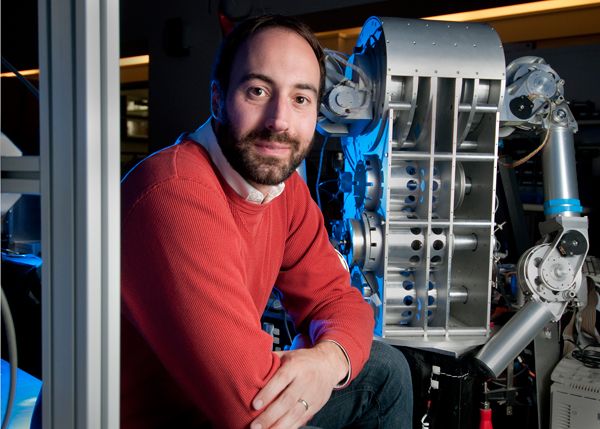Ever wonder who decides how the drones and self-driving cars will work?
Meet the guy. Meet Ryan Calo.
Ryan is one of the figures behind the curtain. As one of the leading robotics law scholars in the country, he gets to figure out how the robots, drones, and self-driving cars will all work today, and in the future.
Ryan is an assistant professor at the University of Washington School of Law, and co-directs the Tech Policy Lab, which spans computer science, law, and information sciences. Ryan’s substantive area of research is in emerging technology and its interaction with law and policy.
I sat down with Ryan to better understand how he saw this robotic revolution coming so far ahead of the pack, and where he sees of it going. Are we doomed to be robot slaves? Read on.
How did you get into robotics law before so many other people?
I started to write about robotics law and policy law while I was a fellow at Stanford Law School. But I’ve always been super interested in robots. My mother, at one point, dug out my middle-school science fair project. This would’ve been in the 80s, or the early, early 90s. It was on robots. It was my impression of industrial robots. I’ve long been interested in the technology, but it’s only in recent years that I’ve come to the view that we need to work on a wise legal and policy infrastructure for the technology.
How did you see the see the need for it coming? How did you time the trend so well?
I was lucky in that my hobby became my vocation. I was always interested in robots, but began to realize that there really was a “there” there. What really did it for me was reading Peter Singer’s book, Wired for War, which talks about the role of robotics in transforming the American military.
If you look at the patterns over time, many transformative technologies, including computers and the internet itself, originated as a military application. Whether we’re talking about code-breaking in World War II or we’re talking about what was then ARPA (what is now DARPA), funding the original research that led to the internet, that all came from military applications. I thought to myself, “Well gosh, these same people who are funding the internet and are catalysts for the internet are now turning to driverless cars and other robots. Hmm.”
I have to say that people don’t necessarily understand how much contact American law has already had with robots. I went back and looked at over half a century of U.S. cases that meaningfully involve robots. I found some gems.
Gems?! Like what?
Really early on, I poked around a little to see if I could find some fun robot cases from the past. I found some fun cases. The first one is one that many lawyers at least are familiar with, which is in the early 90s when Samsung ran an ad that was supposed to be set in the future (2018!) and the ad featured a robot Vanna White. The real-life Vanna White got upset and wound up suing Samsung in a case that went all the way up to the Ninth Circuit Court of Appeals. If you read that case, it’s just fascinating. It is all about whether or not a robot version of a person is that person in the right way.
Not only is there a discussion about Vanna White, but there’s a long discussion of a robot Michael Jordan for some of the real sports fans in the audience. Oh, and there’s also another case called Wendt vs Host International, which is about robot versions of Cliff and Norm from Cheers that somebody made for a bar. Cliff and Norm, the actors behind Cliff and Norm, sued over that.
My head is spinning. I can’t believe Vanna White got things going in robotics law.
She did, she did! Obviously on the side of the case law, the technologies that got me interested in robotics as a real legal issue were drones and driverless cars. This is all developing. I wrote some of the early work on drone privacy. From that, I wound up getting to testify before the Senate judiciary committee a few years ago. With Sven Beiker at Stanford University, I also started a program that looked at the legal and policy aspects of driverless cars. We wound up producing some of the really early reports on the legal and policy aspects of driverless cars. This place where the rubber meets the road, so to speak.
Ha! I see, I see. So how does it work? Right now we can discuss the implications of drone technology and self-driving cars but can the law work proactively to anticipate technology 10 years or 20 years in the future?
I think that it’s important to be thoughtful about technology in advance, even if you can’t fully predict its path. The United States confronted a question very early on in the early days of the internet, which is whether or not we were going to treat platforms like Google or Facebook, as responsible for what users do on the platform. So, between the Digital Money and Copyright Act in section 230 of the Communications Decency Act, we immunized platforms largely for what users do on them. That was really crucial because if we didn’t do that, I don’t think we’d have the proliferation of services and industry that we do today.
I think about what is the version of those Acts for robotics? What early good decision could be made so that we capitalize on this important transformative technology? It’s tricky to think, “How are robots going to play in society? How are they going to interact with the law?” That’s a hard exercise to figure out. There’s really an enormous advantage if you can get it right, basically right from the start.
You’ve publicly called for the US government to create a central robotics commission. How will this work?
The basic thought is that the government needs to be a repository of expertise about robotics. There are pockets of expertise in government about robotics. Right now, it’s all silo-ed. The Security and Exchange Commission is worried about bots trading on the stock market. The Federal Aviation Administration is worried about the safety of drones and the National Highway Transportation Safety administration is worried about driverless cars, and so on and so on. They accrue expertise very slowly and individually.
As a consequence, you don’t necessarily have the people who are making policy decisions with the best mental model of the technology. As a shock to the system and maybe a little bit of rabble-rousing on my part, I proposed, “Why don’t we make a Federal Robotics Commission, much as we created a commission for railroads, communication, vaccines, and more?”.
One example of why this is necessary is if you look at the Toyota sudden acceleration scandal and the VW emissions scandal. These are complex interactions between hardware and software that the government isn’t very good at solving. When people accused Toyota of having a software glitch that caused them to suddenly accelerate, Congress asked the Department of Transportation to figure out if that was true and they couldn’t do it. They had to ask NASA! They had to literally go to NASA and say, “Hey, would you all mind taking a break from putting robots on Mars for a moment. Let’s take a look at this Toyota thing.” It’s not a sustainable strategy. I’ve argued for that. We really need to do what we did with NASA or the NSA before Snowden, which is to create something that people want to go to because it’s the best. The government is capable of attracting the best and the brightest if we all can believe in the mission.
The humanoid robot Pepper (Photo: Aldebaran)
Is there specific robotics technology that makes you say, Holy sh*t! This is way crazier than I even thought?
First of all, I marvel at how fast robotics is changing. It’s still really, really hard. I don’t think we’re going to get anything like human or superhuman intelligence out of robotics anytime in the foreseeable future, but we’re seeing some really interesting developments.
The things that make me stand back and go, “Holy shit!” are some of the mistakes that happened yet no one anticipated. They still tend to be in the digital universe, not quite at the physical level yet. Think about the flash crash, where high speed trading algorithms caused a substantial dip in the market over a short period of time. Or when Google’s image recognition software wound up labeling a picture of an African American couple as gorillas, which was mortifying to Google and deeply offensive to the two individuals. Or a great example is when a bot in Amsterdam specifically threatened a fashion show with violence in a way that nobody who created the bot anticipated, and the police had to be called and responded and asked questions and confiscated the bot.
Those are the kind of things that make me say wow and make me confident that there’s going to be some really interesting questions to answer with law. As we have more IOT develop, and as we have more cyber physical systems, we’ll start to see not just these information-based harms, but much more tangible, even physical harms come out of these systems.
Changing gears, what’s your favorite childhood robot or favorite robot over the last 30 or 40 years?
I have to go with the safe answer here. R2D2 is the iconic robot. That’s the robot of all of our imaginations for the most part, at least those of us who grew up in the 80s.
Did you ever hear about a robot named Topo? Topo was a Japanese robot in the 80s. I was maybe 10 years old. Somehow my mom let me buy a robot magazine, and I became fascinated with this Topo robot. I’ll send you an image of it.
Please do. I don’t know Topo. I’d like to check that one out. The Topo of today would be something like Jibo. If you’re interested in robots, I would totally pre-order a Jibo, if I were you. I think that’s huge. The person behind it is Cynthia Breazeal, who is a famous roboticist out of MIT, and coined the term “social robotics.” Jibo just looks fantastic, and I’m excited. I have a five year old and a two year old at home. I think my five-year-old, he’ll grow up with a Jibo in the house. We won’t have to just pine after Topo the way that you did as a kid.
Over the next 18 months, what is Ryan Calo personally betting on?
I have to tell you that the thing I’ve been thinking about as being a big deal that hasn’t really come up yet is a new ability to purposely control the weather locally. The dream of weather control has been around for a long time, and supposedly we’re doing cloud seeding and other sort of interesting stuff, stirring inversions, and all kinds of interesting things. Given the emphasis that’s being placed on technology to get us out of the climate change horror show that we’re in, I think regardless of whether it winds up being technology that saves us from this or that, we’re going to learn so much through our studying of climate and the weather and our modeling and our ability to affect things, that actually at some point, it will be at least possible to model, and then affect, local weather.
Think about how lucrative that could be. If you could make sure that there’s no rain for South by Southwest or in Dallas during a Cowboys game? It’s the kind of thing that has a huge upside if we can get it right. It’s not immediately within our reach, but it’s the sort of thing that in the next few years might start to spin up.
Mind blown again! Are you reading anything cool right now?
The last thing I read for work was John Markoff’s Machines of Loving Grace. So good. It’s basically a series of wonderful John Markoff articles about robotics and artificial intelligence. I’m about to start reading David Mindell’s new book, which is about automation. It’s about how we’ve been fascinated with automation, what automation really means to us.
Ben is an active VR investor, based in Los Angeles. Ben was an early Google and YouTube exec, and founded and led multiple venture-backed video startups. Read more of his profiles on “The people behind the biggest trends” here.











